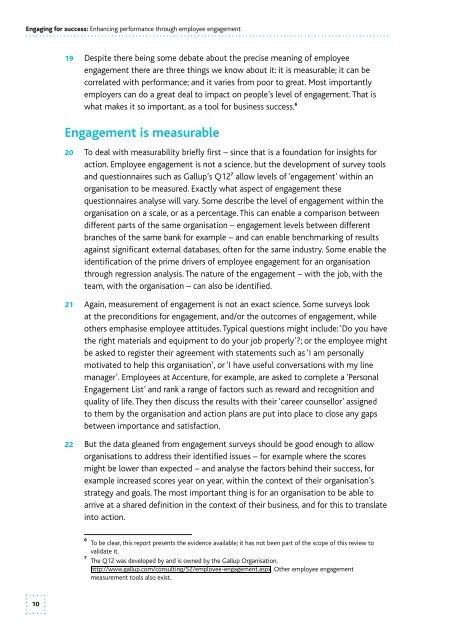3ytgeaf
3ytgeaf
3ytgeaf
You also want an ePaper? Increase the reach of your titles
YUMPU automatically turns print PDFs into web optimized ePapers that Google loves.
Engaging for success: Enhancing performance through employee engagement<br />
19 Despite there being some debate about the precise meaning of employee<br />
engagement there are three things we know about it: it is measurable; it can be<br />
correlated with performance; and it varies from poor to great. Most importantly<br />
employers can do a great deal to impact on people’s level of engagement. That is<br />
what makes it so important, as a tool for business success. 6<br />
Engagement is measurable<br />
20 To deal with measurability briefly first – since that is a foundation for insights for<br />
action. Employee engagement is not a science, but the development of survey tools<br />
and questionnaires such as Gallup’s Q12 7 allow levels of ‘engagement’ within an<br />
organisation to be measured. Exactly what aspect of engagement these<br />
questionnaires analyse will vary. Some describe the level of engagement within the<br />
organisation on a scale, or as a percentage. This can enable a comparison between<br />
different parts of the same organisation – engagement levels between different<br />
branches of the same bank for example – and can enable benchmarking of results<br />
against significant external databases, often for the same industry. Some enable the<br />
identification of the prime drivers of employee engagement for an organisation<br />
through regression analysis. The nature of the engagement – with the job, with the<br />
team, with the organisation – can also be identified.<br />
21 Again, measurement of engagement is not an exact science. Some surveys look<br />
at the preconditions for engagement, and/or the outcomes of engagement, while<br />
others emphasise employee attitudes. Typical questions might include: ‘Do you have<br />
the right materials and equipment to do your job properly’; or the employee might<br />
be asked to register their agreement with statements such as ‘I am personally<br />
motivated to help this organisation’, or ‘I have useful conversations with my line<br />
manager’. Employees at Accenture, for example, are asked to complete a ‘Personal<br />
Engagement List’ and rank a range of factors such as reward and recognition and<br />
quality of life. They then discuss the results with their ‘career counsellor’ assigned<br />
to them by the organisation and action plans are put into place to close any gaps<br />
between importance and satisfaction.<br />
22 But the data gleaned from engagement surveys should be good enough to allow<br />
organisations to address their identified issues – for example where the scores<br />
might be lower than expected – and analyse the factors behind their success, for<br />
example increased scores year on year, within the context of their organisation’s<br />
strategy and goals. The most important thing is for an organisation to be able to<br />
arrive at a shared definition in the context of their business, and for this to translate<br />
into action.<br />
6<br />
7<br />
To be clear, this report presents the evidence available; it has not been part of the scope of this review to<br />
validate it.<br />
The Q12 was developed by and is owned by the Gallup Organisation.<br />
http://www.gallup.com/consulting/52/employee-engagement.aspx. Other employee engagement<br />
measurement tools also exist.<br />
10


